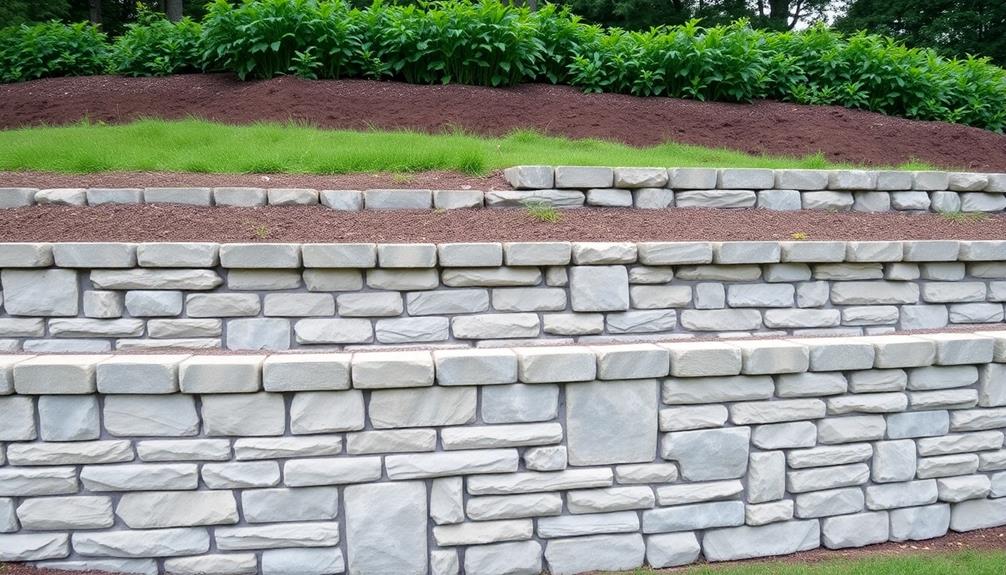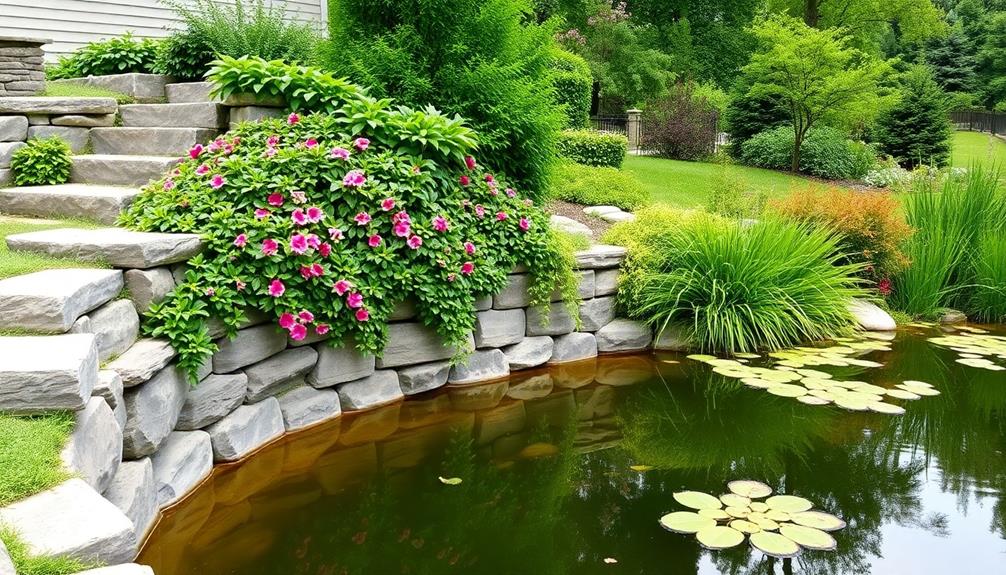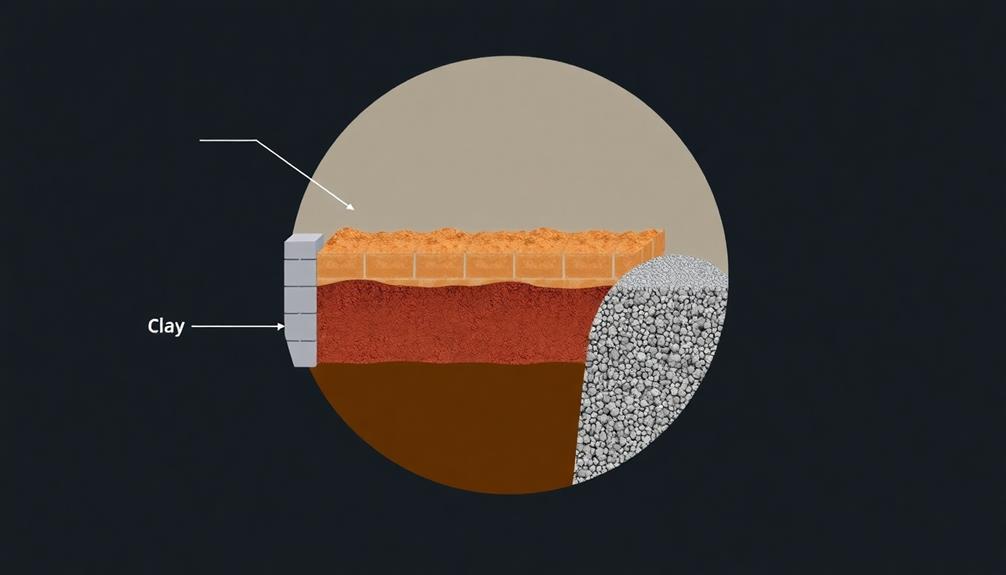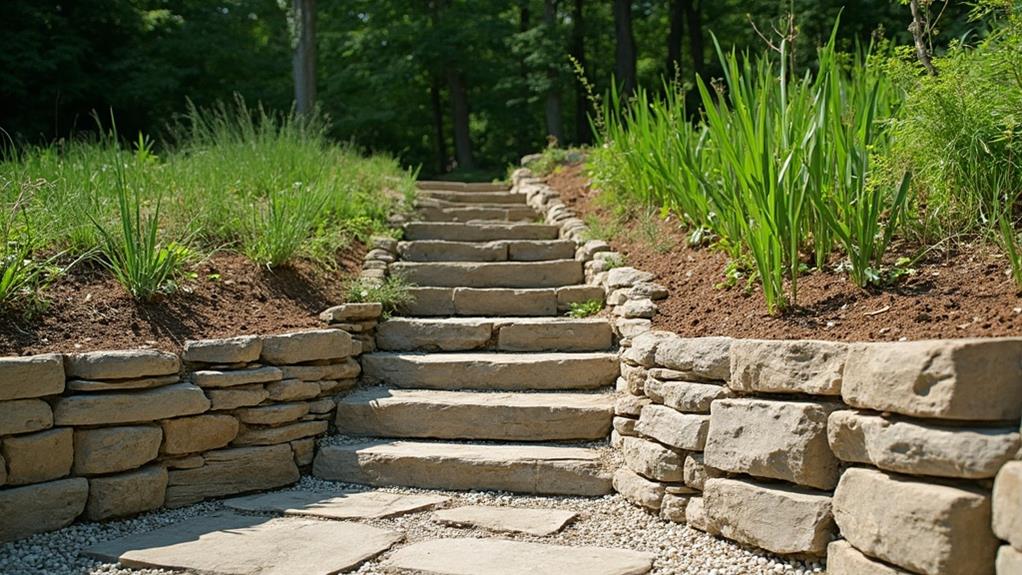Constructing a retaining wall involves a meticulous process starting with site evaluation, which includes analyzing soil composition, slope gradients, and potential drainage issues. The selection of appropriate materials like geogrid and concrete, along with suitable wall design, is pivotal to guarantee the wall's stability and aesthetic appeal. A gravel drainage system is essential for managing water runoff and preventing erosion, particularly in sandy soils. The integration of a drainage pipe and waterproofing elements safeguards against moisture damage. Compliance with local codes and regular maintenance, such as inspecting for cracks and maintaining vegetation, enhance the wall's longevity, offering deeper insights into securing structural effectiveness.
Table of Contents
ToggleWalls Contractor Highlights
- Evaluate the soil type and drainage needs to ensure proper retaining wall design and construction.
- Incorporate gravel drainage systems to enhance wall stability and prevent water accumulation.
- Select materials considering durability and aesthetics, ensuring compliance with local building codes.
- Prepare and stabilize the foundation through excavation, leveling, and proper base installation.
- Regularly monitor and maintain the wall to address potential damage and ensure long-term performance.
Definition of Retaining Wall

A retaining wall is an engineered structure designed to hold back soil and prevent erosion, often utilized to create level areas in landscapes or support infrastructure like roads and pathways. It serves a vital role in stabilizing sloped terrains and is constructed using a variety of materials, such as concrete, stone, or timber, each chosen for their specific advantages in terms of durability, aesthetics, and suitability for the site.
Additionally, one should consider the importance of functional and visually appealing walls, especially when collaborating with landscape architects and structural engineers. Equally important, the design and installation of retaining walls are subject to local building codes and regulations, ensuring their safety and effectiveness in withstanding environmental pressures and loads.
Purpose and Functionality
Standing firm against the test of time and environmental challenges, retaining walls serve as essential structures in landscape engineering. Their primary purpose is to restrain soil and prevent erosion, particularly in terrains where elevation changes sharply. By holding back soil and stabilizing slopes, retaining walls safeguard structures and landscapes from movements that could cause significant damage. These walls effectively manage water runoff by directing its flow and preventing over-saturation of soil, which can lead to slope failure.
A meticulously designed retaining wall not only offers structural integrity but also enhances the aesthetic appeal of a property, contributing to the overall visual harmony of a landscape. It provides usable land in previously unusable spaces, transforming steep slopes into functional areas for gardens, patios, or pathways. In doing so, retaining walls create cohesion between the natural and built environments, fostering a sense of belonging for both the structures and those who inhabit the space.
The functionality of a retaining wall extends beyond mere physical restraint; it symbolizes an intersection of human ingenuity and nature's forces, a record of the enduring commitment to balance and safety. In every corner they stand, retaining walls echo a promise of resilience and unity.
Types and Materials
Exploring various types and materials is crucial to understanding the definition and functionality of retaining walls in landscape design. Retaining walls serve as both a practical and aesthetic solution, used to stabilize soil, prevent erosion, and create usable flat spaces in hilly terrains.
Each type and material of retaining wall offers unique properties that cater to different environmental conditions and design preferences.
Stone retaining walls, crafted from natural stone, provide exceptional durability and blend seamlessly into natural landscapes, exuding timeless elegance. Conversely, wood retaining walls offer rustic charm and are favored for small-scale projects where aesthetics and cost are primary considerations.
For more robust applications, concrete retaining walls are renowned for their structural integrity and flexibility in design, enabling the creation of curves and varied textures. Modular block retaining walls, manufactured from precast concrete, are designed for ease of installation with interlocking features, providing stability even without mortar.
The choice of retaining wall material often correlates with the specific requirements of the landscape and personal preference, reflecting a desire to harmonize human spaces with nature. Understanding these options strengthens community bonds by allowing homeowners to participate in creating beautiful, functional, and enduring outdoor environments.
Design and Regulations
Understanding the intricate interplay between design and regulations is pivotal in the construction of retaining walls. These structures are not merely functional; they embody the harmony between aesthetic vision and compliance with legal standards. A retaining wall must stabilize soil while complementing the surrounding environment, necessitating a well-considered blend of structural integrity and design flair.
Professionals involved in its construction prioritize evaluating the site's conditions, such as soil composition, water drainage, and load-bearing requirements, all of which influence the wall's design.
Navigating regulations involves understanding local building codes and standards, essential for ensuring safety and adherence to community norms. The retaining wall's height, materials, and engineering specifics are often dictated by regional guidelines, which vary greatly. Proper permits must be obtained, thereby underscoring the importance of consulting local authorities or hiring professionals well-versed in these mandates.
Benefits

Constructing a retaining wall offers a multitude of benefits that combine both functional and aesthetic advantages, making it a valuable addition to any landscape. For instance, high-quality retaining walls can be customized in design to suit specific outdoor spaces, enhancing not only their functionality but also their visual appeal.
Primarily, these structures play an essential role in preventing soil erosion, particularly in environments susceptible to heavy rainfall or steep gradients, thereby protecting your landscape and sustaining its soil integrity. In addition to ensuring improved structural stability, retaining walls can enhance the visual appeal of a property and create additional usable space for landscaping or recreational purposes, effectively optimizing your land's functionality and appearance.
Prevent Soil Erosion
Frequently, one of the primary advantages of constructing a retaining wall is its ability to prevent soil erosion, which is essential for maintaining the stability and integrity of any landscape. Soil erosion presents a formidable challenge in landscaping, often resulting in unsightly and unstable land surfaces, and potentially threatening the structural foundation of nearby property. Retaining walls serve as a barrier against the forces of nature, specifically gravitational pull and water flow, that erode topsoil. By holding the soil in place, these structures safeguard that each layer of soil remains intact, thereby fostering a robust environment for vegetation growth and preserving the landscape's natural beauty.
Designed with precision, retaining walls are particularly beneficial in areas with slopes or uneven terrain, as they control runoff and manage drainage effectively. This functionality is critical for community members who aim to nurture their yards into thriving ecosystems, providing peace of mind that their outdoor living spaces are protected from erosion-related issues. Additionally, by mitigating soil erosion, retaining walls enhance the durability of the landscape, reducing maintenance efforts and costs over time. Consequently, these architectural elements support a sense of belonging within the community by upholding the harmonious interaction between manmade structures and the natural environment.
Enhance Property Aesthetics
While retaining walls primarily prevent soil erosion, they also notably enhance property aesthetics by blending functionality with visual appeal. A well-designed retaining wall serves as an artistic medium, transforming any landscape into a stunning visual masterpiece.
By carefully selecting materials such as natural stone, brick, or timber, property owners can introduce texture and variety, enriching the outdoor environment. The subtle incorporation of different colors and finishes allows a retaining wall to seamlessly integrate with the existing aesthetic, creating harmony between newer constructions and the natural surroundings.
Retaining walls offer unique opportunities to delineate spaces in visually pleasing ways, fostering an inviting atmosphere. The thoughtful placement of these walls can guide the eye and shape the landscape's narrative, accentuating garden beds or framing breathtaking views.
Additionally, incorporating elements such as curves or angles adds a dynamic dimension, ensuring that the wall is not just a functional necessity but also a compelling focal point.
Beyond enhancing aesthetic quality, these structures evoke feelings of stability and refinement, thereby enriching the sense of belonging to a well-maintained property. By investing in the visual and structural sophistication of retaining walls, homeowners can witness both their property value and pride in ownership flourish.
Increase Usable Space
Beyond enhancing property aesthetics, retaining walls offer the practical advantage of increasing usable space. By transforming sloped or uneven terrain into level, functional areas, retaining walls empower property owners to make the most out of their land. This transformation allows for the creation of terraces that can accommodate gardens, patios, or even play areas, fostering an environment that caters to the desires and needs of a community-focused lifestyle.
Retaining walls serve to redefine property boundaries in a manner that maximizes both utility and enjoyment. By converting previously unusable sloped grounds into flat sections, these walls enable the installation of features that promote gatherings and social engagements. Consequently, homeowners can incorporate functional spaces such as outdoor kitchens, seating areas, or small sports fields, nurturing a sense of belonging and togetherness.
Moreover, the enhanced use of space can increase the property's value, adding both financial and intrinsic benefits to the investment. The adaptation of erstwhile problematic areas into functional spaces not only improves property utility but also promotes sustainable land use practices, contributing to the environmental wellbeing of the broader community. This harmonious blend of utility and aesthetics exemplifies the multifaceted value that retaining walls offer.
Improve Structural Stability
One of the primary benefits of constructing retaining walls is the significant improvement in structural stability they provide to a landscape. By skillfully integrating these walls into sloped or uneven terrains, they act as a robust barrier against soil erosion and landslides, anchoring the earth and fostering a safe and secure environment. Such stability is particularly essential in residential areas prone to heavy rainfall or seismic activity, which can otherwise compromise the integrity of the landscape.
Retaining walls also protect foundational structures, diverting water away and minimizing pressure that excessive moisture exerts on building bases, thereby preserving their durability over time. This fortification extends the lifespan of properties and reduces maintenance costs, reinforcing a community's investment in its shared spaces.
Different Soil Types Affect Stability

The stability of a retaining wall is greatly influenced by the type of soil it supports, and understanding the characteristics of different soil types is vital for successful construction. Clay soils can present challenges due to their tendency to expand and contract with moisture changes, while sandy soils may lead to stability issues because of their low cohesion and potential for erosion. On the other hand, gravel offers superior drainage properties, which can be advantageous in maintaining the wall's structural integrity.
| Soil Type | Key Characteristics |
|---|---|
| Clay | Expands/Contracts with Water |
| Sand | Low Cohesion and Erosive |
| Gravel | Excellent Drainage |
Understanding these factors can guide the selection of appropriate construction techniques to address the specific challenges posed by each soil type, thereby ensuring long-term durability and safety of the retaining wall structure.
Clay Soil Challenges
Constructing a retaining wall in clay soil presents unique challenges that considerably impact its stability. The primary issue lies in clay's propensity to dramatically expand and contract with changes in moisture content, which can lead to uneven pressure distributions on the wall structure. When saturated, clay can extremely swell, exerting lateral pressure that surpasses standard design expectations and jeopardizing the integrity of the wall. Conversely, during dry periods, clay soil contracts, which may result in gaps between the soil and the wall, reducing its overall support and causing destabilization.
To offset these challenges, it is vital for builders to have a thorough understanding of the properties of clay soil, as this knowledge informs both the design and construction phases. Reinforcement and drainage systems should be meticulously planned; incorporating effective drainage solutions like gravel backfill and perforated pipes can alleviate the effects of excess water accumulation. Additionally, selecting materials with high tensile strength and flexibility can help sustain the wall against the variability in soil pressure.
Ultimately, a well-constructed retaining wall in such conditions necessitates careful design, rigorous planning, and expert execution to maintain stability and longevity, fulfilling the aspirations of those invested in structural resilience and community harmony.
Sand Stability Issues
While clay soils pose considerable challenges due to their moisture-driven variability, sand soils introduce an entirely different set of issues related to stability and structural integrity. Sand lacks cohesive properties, causing it to shift and slide even under a relatively low shear force. This non-cohesive nature can compromise the reliability of retaining walls, which rely on strong lateral support to withstand gravitational forces over time.
To successfully manage these stability issues, it is essential to accurately assess the type and uniformity of the sand in the construction area. Angular sands, as opposed to rounded sands, offer better frictional resistance, thereby increasing stability. Engineers and builders must consider factors such as the gradation and density of the sand to optimize compaction, which aids in enhancing the structural integrity of the wall.
Surfacing the foundational layer with a geotextile fabric can help to mitigate erosion and displacement caused by water flow, while also improving load distribution. Additionally, employing techniques such as soil stabilization, possibly with additives or admixtures, can substantially augment the sand's structural properties. A thorough understanding of these aspects promotes not only the strength and longevity of the retaining wall but also aligns the construction with locally accepted best practices.
Gravel Drainage Benefits
Integrating gravel drainage into retaining wall designs greatly enhances their ability to manage water flow and maintain stability across diverse soil types. Gravel, characterized by its permeability, facilitates efficient water drainage, thereby preventing water accumulation which could compromise the wall's structural integrity. In environments where clay soil predominates, gravel drainage becomes indispensable due to clay's low permeability and propensity to retain water, which can exert hydrostatic pressure behind the wall.
By allowing water to escape, gravel drainage mitigates these pressures, consequently enhancing the durability and lifespan of the retaining wall.
In sandy soils, which naturally allow water to percolate but can be prone to erosion, gravel helps to stabilize the retained earth by offering a buffer against water flow. This characteristic of gravel bolsters the structural interface between the sand and the wall, providing a more cohesive system that resists shifting and settling.
For loamy soils, which offer a balance of drainage and fertility, gravel serves to regulate excess moisture levels, preserving suitable conditions for both soil conservation and retaining wall performance. Hence, choosing to incorporate gravel drainage systems within retaining walls is a prudent strategy to accommodate varying soil types, ensuring safety and longevity.
Walls Contractor FAQ
How Deep Should the Footing Be for a Retaining Wall?
The depth of a retaining wall footing should be below the frost line or at least one-third of the wall's projected height. This guarantees stability and resilience, fostering a safe and inclusive environment for your community.
What Is the Recommended Height Limit for a DIY Retaining Wall?
For a do-it-yourself retaining wall, the recommended height limit is generally three to four feet. This measurement guarantees stability and safety, fostering confidence in your construction while aligning with community standards for non-professional installations.
Do I Need a Drainage System Behind My Retaining Wall?
Yes, implementing an effective drainage system behind your retaining wall is essential. It prevents hydrostatic pressure buildup, ensuring long-term stability and performance, especially for DIY enthusiasts aiming to create durable and reliable structures in their landscape projects.
What Type of Reinforcement Is Needed for Taller Retaining Walls?
For taller retaining walls, incorporating suitable reinforcement like geogrid, steel rods, or concrete blocks is essential. This reinforces structural integrity, enhances safety, and guarantees longevity, thereby fostering a safer environment for your cherished community's outdoor spaces.
How Do I Address Potential Frost Heave Issues With Retaining Walls?
Addressing frost heave involves using frost-resistant materials and ensuring proper drainage to minimize water accumulation. Adequate insulation can prevent frost penetration, while conducting a thorough site analysis helps anticipate and mitigate potential frost-related challenges effectively, ensuring structural stability.







